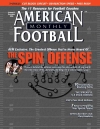AMERICAN FOOTBALL MONTHLY THE #1 RESOURCE FOR FOOTBALL COACHES
Article CategoriesAFM Magazine
|
Sticking to the Scriptby: Dan Weil© More from this issue Many coaches believe in the philosophy of scripting your first 10-15 offensive plays of the game and a few less than that for the second half. The idea is to make it easier for your players to have early success and to learn how the defense will react to some of your core plays. We talked to three coaches for their philosophies about scripted plays and for information about the kind of plays they actually put into their scripts. The coaches are Tommy Condell, OC of the CFL’s Saskatchewan Rough Riders and formerly a coach at several U.S. colleges, including offensive coordinator at University of Louisiana-Monroe; Kenny Edenfield, offensive coordinator at University of North Alabama; and Steve Specht, head coach at St. Xavier High School in Cincinnati. Steve Specht....The full article can only be seen by subscribers. Subscribe today!
|
|
|||||||
| HOME |
MAGAZINE |
SUBSCRIBE | ONLINE COLUMNISTS | COACHING VIDEOS |
Copyright 2025, AmericanFootballMonthly.com
All Rights Reserved





